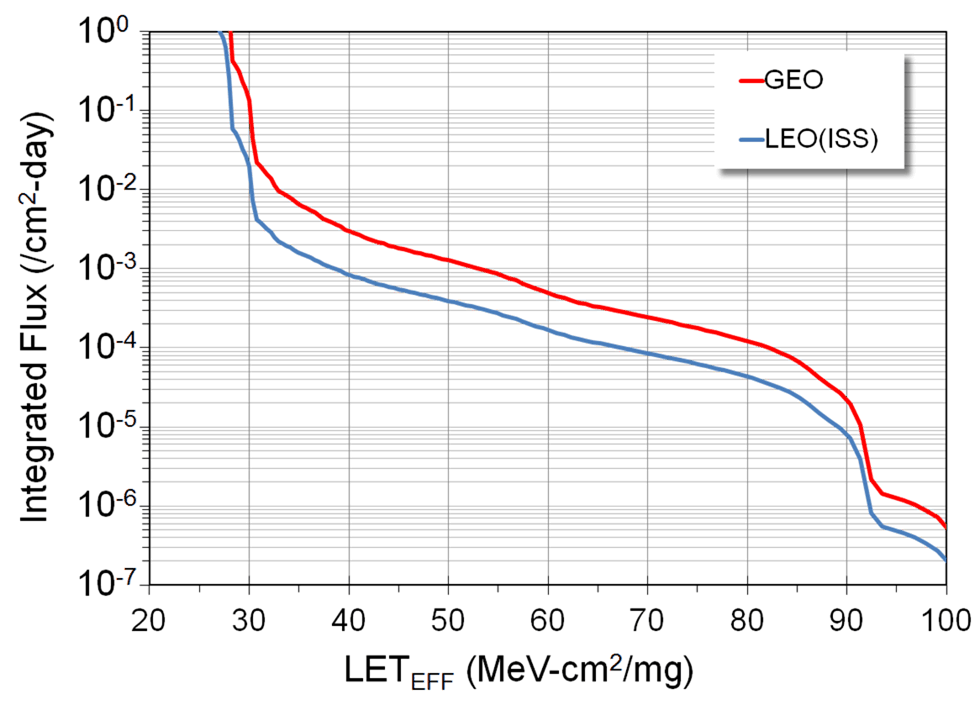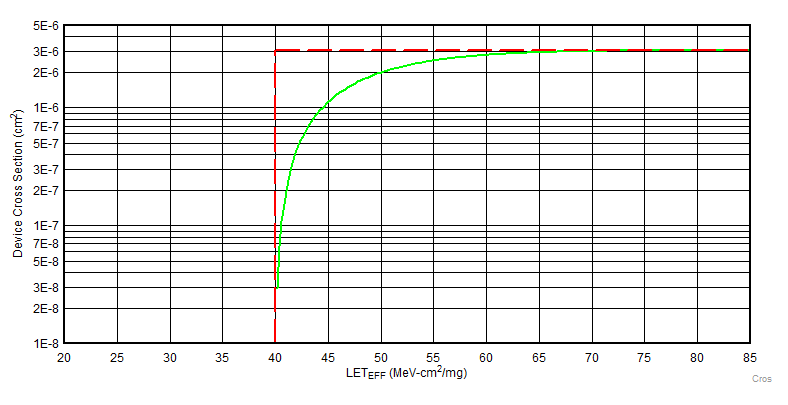SBOA564A December 2022 – August 2024 TRF0206-SP
- 1
- Single-Event Effects Test Report of the TRF0206-SP 6.5-GHz Differential Amplifier
- Trademarks
- 1 Overview
- 2 Single-Event Effects
- 3 Test Device and Evaluation Board Information
- 4 Irradiation Facility and Setup
- 5 Depth, Range, and LETEFF Calculation
- 6 Test Set-Up and Procedures
- 7 Single-Event Latch-up (SEL) Results
- 8 Single-Event Transients (SET) Results
- 9 Event Rate Calculations
- 10Summary
- A Total Ionizing Dose from SEE Experiments
- B Confidence Interval Calculations
- C Orbital Environment Estimations
- D References
- E Revision History
C Orbital Environment Estimations
To calculate on-orbit SEE event rates, one needs both the device SEE cross-section and the flux of particles encountered in a particular orbit. Device SEE cross-sections are usually determined experimentally while flux of particles in orbit is calculated using various codes. For the purpose of generating some event rates, a Low-Earth Orbit (LEO) and a Geostationary-Earth Orbit (GEO) were calculated using CREME96. CREME96 code, short for Cosmic Ray Effects on Micro-Electronics is a suite of programs [6][7] that enable estimation of the radiation environment in near-Earth orbits. CREME96 is one several tools available in the aerospace industry to provide accurate space environment calculations. Over the years since its introduction, the CREME models have been compared with on-orbit data and demonstrated their accuracy. In particular, CREME96 incorporates realistic worst-case solar particle event models, where fluxes can increase by several orders-of-magnitude over short periods of time.
For the purposes of generating conservative event rates, the worst-week model (based on the biggest solar event lasting a week in the last 45 years) was selected, which has been equated to a 99%-confidence level worst-case event [8][9]. The integrated flux includes protons to heavy ions from solar and galactic sources. A minimal shielding configuration is assumed at 100 mils (2.54 mm) of aluminum. Two orbital environments were estimated, that of the International Space Station (ISS), which is LEO, and the GEO environment. Figure 13-1 shows the integrated flux (from high LET to low) for these two environments.

Using this data, we can extract integral particle fluxes for any arbitrary LET of interest. To simplify the calculation of event rates we assume that all cross-section curves are square – meaning that below the onset LET the cross-section is identically zero while above the onset LET the cross-section is uniformly equal to the saturation cross-section. Figure 13-2 shows the approximation, with the green curve being the actual Weibull fit to the data with the square approximation shown as the red-dashed line. This allows us to calculate event rates with a single multiplication, the event rate becoming simply the product of the integral flux at the onset LET, and the saturation cross-section. Obviously this leads to an over-estimation of the event rate since the area under the square approximation is larger than the actual cross-section curve – but for the purposes of calculating upper-bound event rate estimates, this modification avoids the need to do the integral over the flux and cross-section curves.

To demonstrate how the event rates in this report were calculated, assume that we wish to calculate an event rate for a GEO orbit for the device whose cross-section is shown in Figure 13-2. Using the red curve in Figure 13-1 and the onset LET value obtained from Figure 13-2 (≅ 40 MeV-cm2/mg) we find the GEO integral flux to be ≅ 2.97 × 10–3 ions/cm2-day. The event rate is the product of the integral flux and the saturation cross-section in Figure 13-2 (≅ 3.09 × 10–6 cm2):